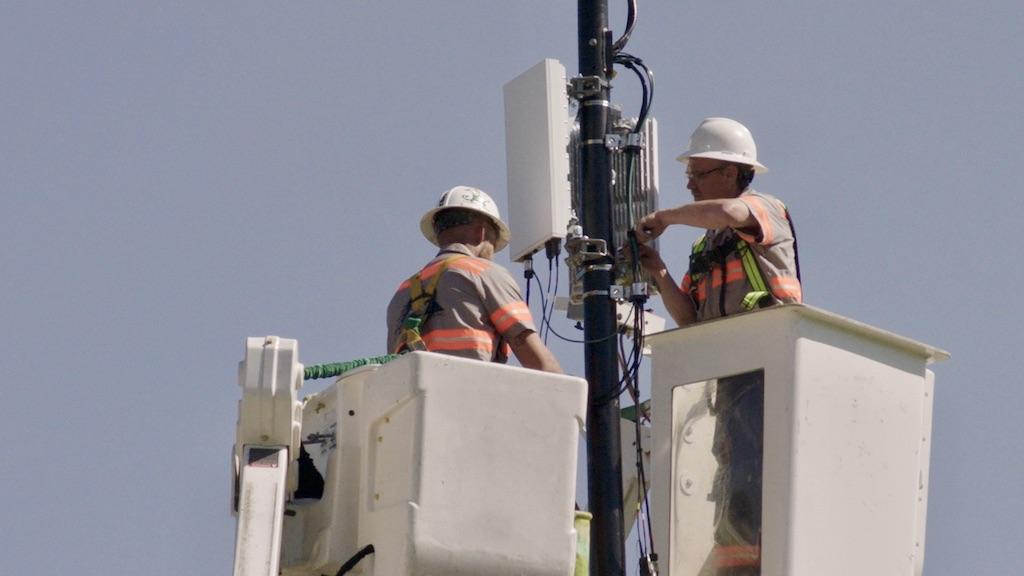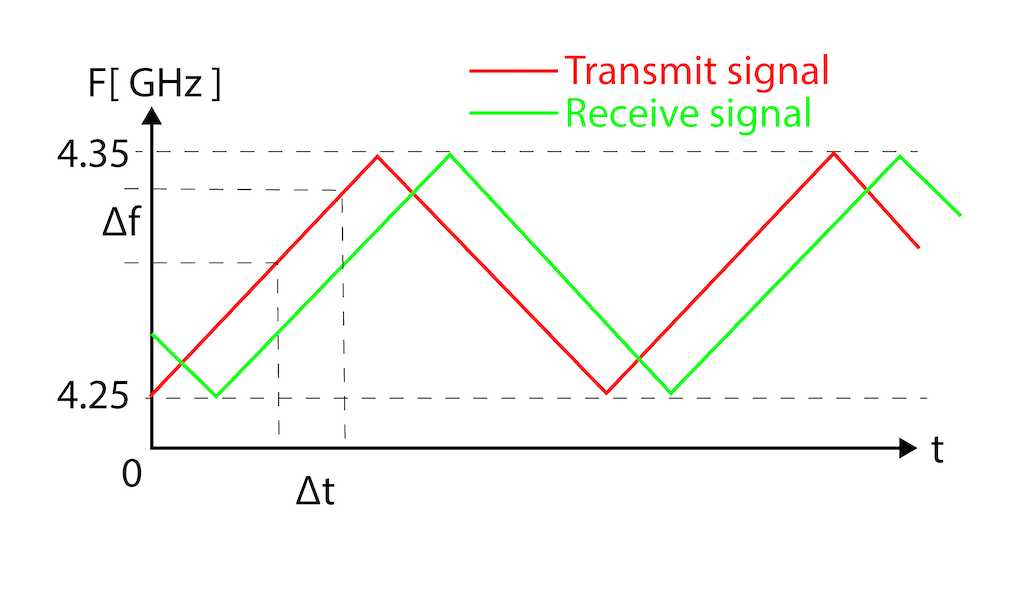
The first part of this article series, 5G, A (Try not to) Crash Course, Part 1, provides insight into how we got to the 5G spectrum situation.
From 1990 to 2015, the number of worldwide mobile subscriptions has exploded from around 12 million to nearly 8 billion. Even with the increased number of frequencies used by 4G systems and improved data handling, the worldwide appetite for bandwidth means we need more frequencies. We’ve exhausted the lower frequency bands, so the next direction is up.
Most of the existing mobile spectrum is between 300 MHz and 5 GHz. Lower frequency bands cover wider areas because they can penetrate objects effectively and thus travel further, including inside buildings. This means you can get by with fewer towers. But these bands tend to have lower capacity because the spectrum is in limited supply, so only narrow bands tend to be available. Coverage from higher frequencies is smaller because the signals can be weakened or stopped by obstacles, such as buildings. For this reason, higher frequencies require more towers. But higher frequencies allow broader frequency bands, allowing more data to be transferred. The result is the next generation, 5G, which carries more data and has speeds that can reach 1.8 Gbps.
Is 5G inevitable? Probably. We should never discount the possibility that the next best thing in technology is something nobody can imagine today. But for now, it seems 5G is coming. So, if 5G is inevitable, what is the problem? For most of the public, it is all those towers. Studies estimate that it will take 13 million utility-pole-mounted base stations in the U.S. to bring 1.0 Gbps to 55% of the population. The cost is estimated at $400 billion. For us in aviation, however, the problem could be worse than an unsightly cell tower or the price tag of the service.
Are Radio Altimeters At Risk? Possibly.

You may have heard that the signal from a 5G tower or cellphone can interrupt the signal to and from your radio altimeter, with tragic impact. Maybe. Understanding the potential problem requires a deeper dive into radio altimeters, certification and the 5G frequency spectrum.
If you want to understand how your radio altimeter works, I recommend looking at Andreas Horn’s article at www.engineeringpilot.com. He has graciously allowed me to paraphrase his work.
Most radar altimeters used in aviation employ the so-called Frequency-Modulated Continuous Wave (FMCW) principle. A carrier signal is modulated to produce a “sweep” over a given frequency range. This signal is transmitted via a transmission antenna to the ground. After propagation, the reflected signal is received via another dedicated receiver antenna. Part of the transmitted signal is coupled into the receiver path, where it is mixed with the received signal. This permits the determination of the frequency shift, which is representative for the propagation time and thus the distance traveled, which gives you the radio altitude.
The electronics involved are often analog and thus quite sensitive to interference. Only few, more modern designs are based on digital technology which is more tolerant to disturbances. Most radio altimeters were designed under RTCA Minimum Operational Performance Standard (MOPS) DO-155, which in its legacy form does not mandate specific interference protection. High Intensity Radiation Field (HIRF) guidelines used for current airworthiness certification were calculated based on known transmission sources at the time, and 5G didn’t exist then. In other words, the electric field strength levels in the current HIRF environments might not ensure sufficient protection against 5G interference.
Standards organization RTCA, originally known as the Radio Technical Commission for Aeronautics, established a task force to investigate the potential interference risk. The interference tolerance of typical radar altimeters was determined using bench testing. Then, a simulation was carried out to determine the typical interference levels “seen” by an operational aircraft in a 5G-environment. The report determined that significant interference must be expected, should the 5G communication systems be rolled-out without precautions.
5G Around The World

You may also have heard that the 5G problem for aviators is more acute in the U.S. than in other parts of the world. Radio altimeters operate at frequencies in the 4.2-4.4 GHz band. In most parts of the world, the lower-frequency 5G bands go no higher than 3.8 GHz, providing a 0.4 GHz (400 megahertz) buffer. But in the U.S., the band in question ends at 3.98 GHz, reducing our margin to 0.22 GHz (220 megahertz), about half. Some countries shave the margin even more thinly.
So, is your radio altimeter at risk to interference from 5G cellular systems? Possibly, but we don’t have definitive proof of this. The RTCA says we should expect it.
Is The FAA’s Response Adequate? Probably Not.
In December 2021, the FAA issued Safety Alert for Operators (SAFO) 21007, Risk of Potential Adverse Effects on Radio Altimeters when Operating in the Presence of 5G C-Band Interference. The SAFO warns us: “Operators and pilots should be aware of aircraft systems that integrate the radio altimeter and should follow all Standard Operating Procedures related to aircraft safety system aural warnings/alerts.”
On Jan. 13, 2022, the FAA issued 1,478 5G NOTAMS for airspace, aerodromes, instrument approach procedures and for special instrument approach procedures. Looking at an example aerodrome NOTAM can provide an idea of what to expect:
BDL AD AP RDO ALTIMETER UNREL. AUTOLAND, HUD TO TOUCHDOWN, ENHANCED FLT VISION SYSTEMS TO TOUCHDOWN NOT AUTHORIZED EXC FOR ACFT USING APPROVED ALTERNATIVE METHODS OF COMPLIANCE DUE TO 5G C-BAND INTERFERENCE PLUS SEE AIRWORTHINESS DIRECTIVE 2021-23-12
Are Reading and Following NOTAMs Enough? No.
Reading the example NOTAM could lead you to believe that if you are not using autoland, HUD-to-touchdown, or enhanced flight vision systems to touchdown, you have nothing to worry about. Looking at a list of possible affected systems given in the SAFO should dispel that notion:
- Class A Terrain Awareness Warning Systems (TAWS-A)
- Enhanced Ground Proximity Warning Systems (EGPWS)
- Traffic Alert and Collision Avoidance Systems (TCAS II)
- Take-off guidance systems
- Flight Control (control surface)
- Tail strike prevention systems
- Windshear detection systems
- Envelope Protection Systems
- Altitude safety call outs/alerts
- Autothrottle
- Thrust reversers
- Flight Director
- Primary Flight Display of height above ground
- Alert/warning or alert/warning inhibit
- Stick pusher / stick shaker
- Engine and wing anti-ice systems
- Automatic Flight Guidance and Control Systems (AFGCS)
Modern aircraft can be thought of as being more holistic than ever, just about everything is connected to just about everything else. You can no longer trace a schematic and definitely say that one particular system has no impact on others. For example, my aircraft, a Gulfstream GVII, filters Crew Alerting System (CAS) messages on a “need to know” basis. If we have an engine fire on takeoff, we don’t get a warning until passing 400 ft. above the ground. Will 5G interference rob me of that information at a higher altitude? I don’t know.
It could very well be that this is much ado about nothing. It could be that the 220 MHz buffer between 5G signals in the U.S. and our radio altimeters is more than ample. But I don’t like trusting my fate to the word “could.” The frequency auction in the U.S. earned the U.S. Federal Communications Commission over $81 billion in licensing fees. Can’t a portion of that fully pay for a definitive study?
There are a lot of unknowns in this 5G mess and I hope it doesn’t take something catastrophic in aviation to force a solution. The public’s hunger for more bandwidth could be tempered by a realization that getting on an airplane is no longer as safe as they’ve come to appreciate. Or we may figure out a short-term solution to increase the frequency buffers and a long-term answer to redesign existing radio altimeters.
I think it is just as likely that the 5G price tag will inspire a 6G solution that makes all of this moot. As a professional pilot, my answer will be to watch everything like a hawk, suspect anything with a radio altimeter interface, and insist that crew and passengers place their cell phones in airplane mode when flying with me.
5G, A (Try not to) Crash Course, Part 1: https://aviationweek.com/business-aviation/safety-ops-regulation/5g-try…






Comments
Japan and Canada seem to have a smaller buffer between 5G and Radio Altimeters, only the EU is safer than the US. The US 4.94-4.99 is even further away, though above rather than below. Is this a case of the real matter being lost due to over-simplification, i.e. need to read Andreas Horn’s article?